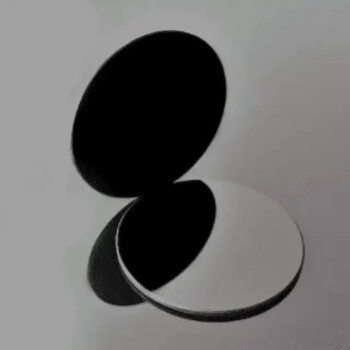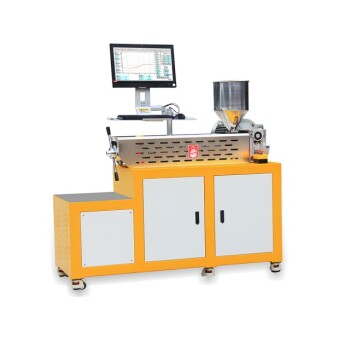In essence, Infrared (IR) spectroscopy is a powerful and widely used analytical technique for identifying the chemical building blocks—known as functional groups—within a molecule. Its applications are vast, spanning from quality control in pharmaceutical manufacturing and forensic analysis of crime scene evidence to environmental monitoring and food safety verification. It works by measuring how a molecule's chemical bonds vibrate when exposed to infrared light, creating a unique spectral "fingerprint."
IR spectroscopy's core value lies in its ability to rapidly and non-destructively identify the structural components of organic and inorganic compounds. This makes it an indispensable tool for confirming a substance's identity, assessing its purity, and understanding its chemical composition.

The Fundamental Principle: How IR Spectroscopy Works
To understand its applications, you must first grasp the principle. IR spectroscopy is fundamentally about molecular vibrations.
Molecules as Vibrating Springs
Think of the chemical bonds between atoms in a molecule as tiny springs. These springs can stretch, bend, and twist in various ways. Each type of bond (like a C-H, O-H, or C=O bond) vibrates at a specific, characteristic frequency.
Probing Bonds with Light
When infrared light is passed through a sample, the bonds absorb the energy from the light that matches their natural vibrational frequency. The instrument records which frequencies of light are absorbed and to what extent.
The IR Spectrum: A Molecular Fingerprint
The resulting plot of absorption versus frequency is the IR spectrum. This spectrum is a unique signature for that molecule. It's composed of two key areas.
- Functional Group Region: A section of the spectrum where common functional groups (alcohols, ketones, amines) reliably appear.
- Fingerprint Region: A more complex and unique region below 1500 cm⁻¹ that is characteristic of the molecule as a whole.
Core Applications Across Industries
Because every molecule has a unique vibrational signature, IR spectroscopy is used in nearly every field of science and industry where chemical identification is necessary.
Chemical and Pharmaceutical Industries
This is one of the largest areas of use. IR is employed for raw material verification, ensuring that the correct starting materials are used before production begins. It's also used for quality control of finished products, confirming the final drug or chemical is the correct compound and free of impurities.
Forensic Science
In forensics, IR is used to analyze trace evidence. It can non-destructively identify illicit drugs, fibers from clothing, paint chips from vehicles, and inks, helping to link suspects to crime scenes.
Environmental Science
Scientists use IR spectroscopy to monitor air and water quality. It can detect the presence of pollutants like carbon monoxide (CO), hydrocarbons, and other volatile organic compounds (VOCs) in the environment.
Materials and Polymer Science
IR is crucial for identifying polymers and plastics. It can determine the composition of an unknown plastic, study the degradation of polymers due to light or heat, and verify the correct additives have been blended into a material.
Food Science
The technique helps ensure food authenticity and safety. It can be used to measure the fat, protein, and moisture content of foods, detect adulteration (e.g., watering down milk), and identify contaminants.
Understanding the Trade-offs and Limitations
While powerful, IR spectroscopy is not a universal solution. Understanding its limitations is key to using it effectively.
Poor for Atomic Species
IR relies on bond vibrations. Therefore, it cannot detect single atoms or monatomic species like noble gases (He, Ar) or ions in a salt (like Na⁺ in NaCl).
Complexity of Mixtures
Interpreting the spectrum of a complex mixture can be extremely difficult. The peaks from different components overlap, creating a convoluted signal that is hard to decipher without advanced software or separation techniques.
Water Interference
Water is a very strong absorber of IR radiation. This makes it a poor solvent for many IR experiments, as its broad, intense peaks can obscure the signals from the sample of interest. This is why many samples are prepared as solids or in non-aqueous solvents.
Primarily Qualitative, Not Quantitative
IR spectroscopy excels at answering "What is this substance?" It is less effective at answering "How much of it is there?" While quantitative analysis is possible, it often requires extensive calibration and is generally less precise than techniques like chromatography or UV-Vis spectroscopy.
Applying IR Spectroscopy to Your Goal
The right application depends entirely on your objective. Use these guidelines to determine if IR is the correct tool for your task.
- If your primary focus is rapid quality control: Use IR to quickly verify the identity and purity of known raw materials or finished products by comparing their spectra to a standard reference.
- If your primary focus is chemical synthesis: Employ IR to confirm the success of a reaction by looking for the disappearance of a reactant's functional group and the appearance of a product's functional group.
- If your primary focus is forensic analysis: Use IR to non-destructively identify unknown solid or liquid substances like drugs, fibers, or paints found as evidence.
- If your primary focus is precise quantification of a mixture: Consider alternative techniques like HPLC or GC, as IR provides less accurate concentration data without significant method development.
By understanding a molecule's vibrational signature, IR spectroscopy provides a clear and rapid path to identifying its fundamental structure and function.
Summary Table:
| Application Area | Primary Use of IR Spectroscopy |
|---|---|
| Pharmaceuticals | Raw material verification, quality control of finished drugs |
| Forensic Science | Identification of illicit drugs, fibers, paints, and inks |
| Environmental Science | Monitoring air/water pollutants like CO and VOCs |
| Materials Science | Polymer identification and degradation analysis |
| Food Science | Ensuring authenticity, detecting adulteration, measuring components |
Need to identify chemical structures or verify material purity in your lab? IR spectroscopy is a cornerstone technique for rapid, non-destructive analysis. KINTEK specializes in providing high-quality lab equipment and consumables to meet your laboratory's needs. Whether you're in pharmaceuticals, forensics, or materials research, we have the right tools to support your work. Contact us today to find the perfect IR solution for your application!
Visual Guide

Related Products
- Laboratory Test Sieves and Sieving Machines
- Infrared Thermal Imaging Temperature Measurement Double-Sided Coated Germanium Ge Lens
- Laboratory Sterilizer Lab Autoclave Vertical Pressure Steam Sterilizer for Liquid Crystal Display Automatic Type
- Laboratory Sterilizer Lab Autoclave Pulse Vacuum Lifting Sterilizer
- Benchtop Laboratory Vacuum Freeze Dryer
People Also Ask
- What range of particle size does the sieve analysis apply? Master the 25 Micron to 1 mm Standard
- How long do I run my sieve shaker for? Find Your Material's Optimal Sieving Time
- What are advantages and disadvantages of sieving method? A Guide to Reliable & Cost-Effective Particle Sizing
- What are the steps in sieving method? A Guide to Accurate Particle Size Separation
- What type of materials can be separated using the method of sieving? A Guide to Efficient Particle Size Separation














